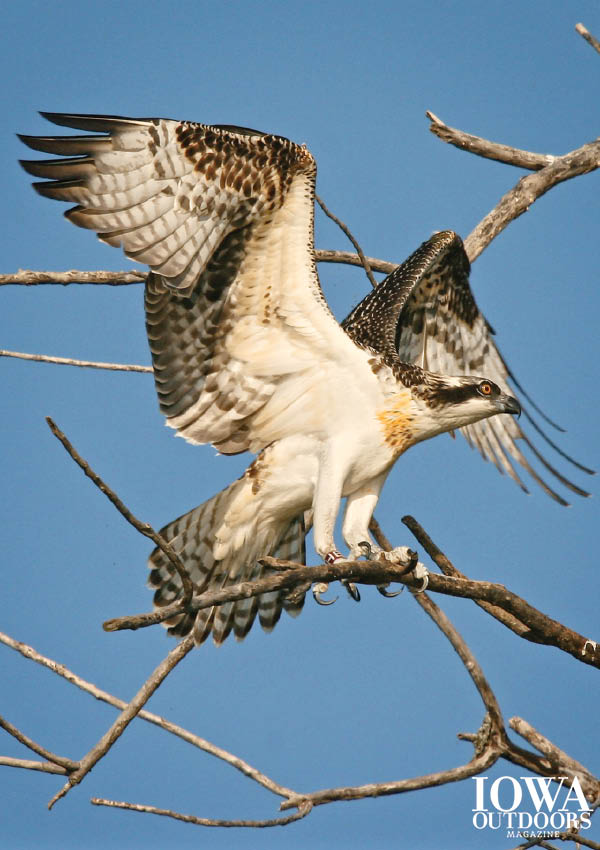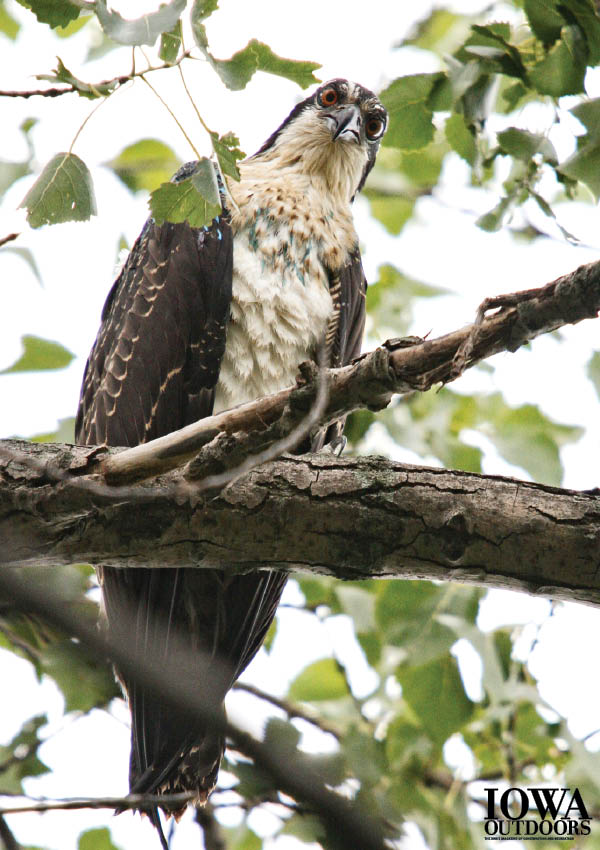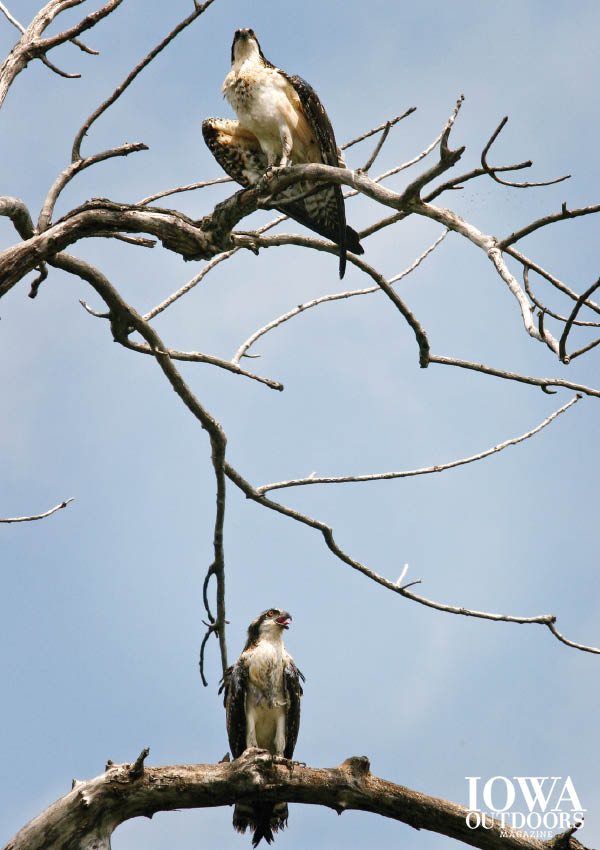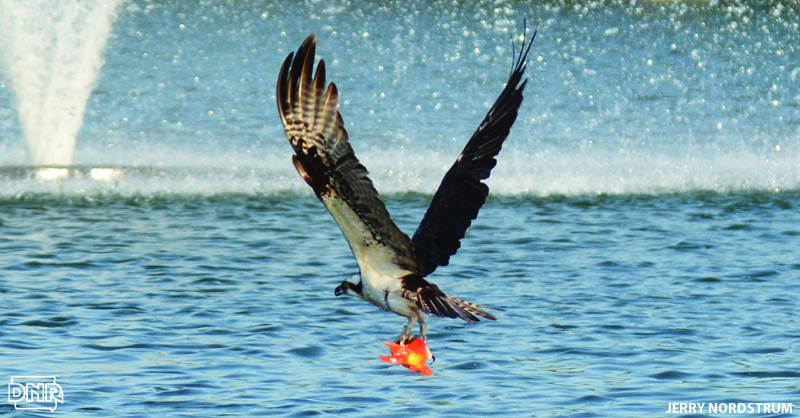From the May/June 2017 issue of Iowa Outdoors magazine
Subscribe now
From a hundred feet in the air, a hovering angler folds its wings, silently slipping downward like lightning from the sky, careening until a four-foot portion of the lake thunders into plumes of diamondized water droplets. Completely immersed, the feathered predator floats to the surface, emerging with a fish in its talons. The bird pushes against the water with its wings, then hops through water’s cohesive forces. A third, then fourth, labored wing-beat increases its height from the lake’s surface.
 In a remarkable finale, the fishing raptor shakes off excess water like a wriggling dog while again gliding ever so closely to the lake’s shimmering surface. Positioning the fish straight ahead, torpedo-style in its talons, the osprey begins stroking upward, its slippery prey secured. Watching this incredible display of feathered fishing perfection reminds you how ineffectual human anglers are versus an osprey.
In a remarkable finale, the fishing raptor shakes off excess water like a wriggling dog while again gliding ever so closely to the lake’s shimmering surface. Positioning the fish straight ahead, torpedo-style in its talons, the osprey begins stroking upward, its slippery prey secured. Watching this incredible display of feathered fishing perfection reminds you how ineffectual human anglers are versus an osprey.
Ospreys are well equipped for obtaining a fish meal. They can see five times more clearly than people to easily spot prey. As archers realize when bow-fishing, underwater targets are not where they appear, an optical illusion created as light refracts or bends after entering water. Ospreys know to compensate and strike their fish where it actually is beneath the surface versus where it appears. In flight, ospreys close the nictitating membrane, a thin layer of clear tissue like an inner eyelid, over their eyes to keep the eye moist. During a dive the membrane protects the eyes when ospreys wallop the water.
They are the only raptor with nose flaps that close, so they can grab fish up to three feet under the surface. The ospreys’ pale-bluish toes are tipped with nature’s finest fishhooks—talons, sharp as needles. Toes have roughened protuberances or “spicules” to hold slippery fish, and outside toes are capable of swiveling backward to join the rear toe or “hallux” (two toes clamping with two toes versus the standard three toes and hallux). This allows grasping fish torpedo-style, which reduces wind resistance in flight. Ospreys can also vertically lift off from water, unlike most birds that use the surface more like a runway. To do so, osprey use specialized wrist joints or carpals. These anatomical tools make ospreys unique among raptors. No other birds of prey combine all of these capabilities into one species.
Return of Iowa’s Ospreys
Prior to recent reintroduction, there was no documented evidence of osprey nesting in Iowa since settlement as Iowa’s earliest Europeans viewed ospreys as competition for fish and the species was quickly eradicated. A report in 1892 indicated a nest might have occurred along the Cedar River, but the addled egg was not recognized by the Iowa Ornithologists’ Union of that time as positive proof. But according to tribal elders of the Omaha and Yankton nations, accounts of ospreys nesting along Iowa waterways are included in their traditional stories. These indigenous people have lived throughout northwestern Iowa for thousands of years.
 Male ospreys show strong fidelity to ancestral breeding areas, preferring to nest colonially where adults originated. Females may disperse hundreds of miles from their origin. However, males generally return within about 100 miles of their origin in Iowa. Due to these very low dispersal tendencies by males, young ospreys are prime candidates for relocation. Conservation efforts help spread young to geographically diverse areas that lack nesting osprey. This strategy will improve nestling survival and complete distribution across the nation.
Male ospreys show strong fidelity to ancestral breeding areas, preferring to nest colonially where adults originated. Females may disperse hundreds of miles from their origin. However, males generally return within about 100 miles of their origin in Iowa. Due to these very low dispersal tendencies by males, young ospreys are prime candidates for relocation. Conservation efforts help spread young to geographically diverse areas that lack nesting osprey. This strategy will improve nestling survival and complete distribution across the nation.
With construction of lakes and reservoirs by the DNR, county conservation boards, private industry, and the U.S. Army Corps of Engineers, potential osprey habitat exists today that was previously unavailable. There are numerous summertime sightings of osprey in Iowa, but these young, non-breeding birds evidently return to where they were reared for mating and nesting. During the last 20 years, the number of migrants through Iowa has increased as breeding populations to the north have grown. Despite this, little expansion of their breeding range is taking place naturally. Minnesota and Wisconsin DNR officials suggest that ospreys, in our lifetime, do not readily pioneer new breeding ranges. Instead, they experience suppressed reproduction as density of nesting pairs increase. Scientists know that raptor populations are in jeopardy of crashing when the average fledging success of young per nest approaches 0.8 chicks per nest. To avoid this, young osprey from Wisconsin and Minnesota are being relocated to areas with suitable habitat in southern Minnesota, Iowa, South Dakota, Kansas, Missouri and Ohio.
In early July, young ospreys in Minnesota and Wisconsin are evaluated for potential relocation. Nests with more than one young are located and staff from The Raptor Center in St. Paul examine ospreys for relocation suitability. When approved, birds are driven to release sites and placed in carefully constructed release towers called hack sites. Hack sites are predator-proof 8-foot cubes with bars on the front that provide visibility of surroundings. By quietly viewing ospreys through one-way mirrored glass or from monitors, detailed observations of each bird’s temperament and condition are logged daily. Trained volunteers feed the young in a manner so the birds do not imprint on people.
 When ospreys are approximately 53 days of age, they are full-grown with rapidly developing feathers and are ready for release. The birds are heavier than adults, due to built-in fat reserves until self-sufficiency is achieved. The bars or gate are opened to release the osprey. Great care is exercised to ensure young are not startled into their first flight—at this stage of development, the less disturbance or drama, the better. Once ospreys have flown, volunteer spotters monitor the birds’ movements, either from shore or in boats for the first few days. Young ospreys can fly well the first time out, but the return landing is difficult. As with other raptors, returning to a perch near the hack box can be fatal for young flyers. After ospreys fledge, volunteers supplement the birds’ diets with fish at the hack site, until birds begin fishing on their own and self-sufficiency is achieved.
When ospreys are approximately 53 days of age, they are full-grown with rapidly developing feathers and are ready for release. The birds are heavier than adults, due to built-in fat reserves until self-sufficiency is achieved. The bars or gate are opened to release the osprey. Great care is exercised to ensure young are not startled into their first flight—at this stage of development, the less disturbance or drama, the better. Once ospreys have flown, volunteer spotters monitor the birds’ movements, either from shore or in boats for the first few days. Young ospreys can fly well the first time out, but the return landing is difficult. As with other raptors, returning to a perch near the hack box can be fatal for young flyers. After ospreys fledge, volunteers supplement the birds’ diets with fish at the hack site, until birds begin fishing on their own and self-sufficiency is achieved.
The DNR assists conservation partners with technical assistance, encouragement and fish to successfully release ospreys in Iowa. Jodeane Cancilla, now with Raptor Advocacy Rehabilitation and Education, spearheaded the work when she was with the Macbride Raptor Project located near Coralville Reservoir. Beginning in 1997, four or five young ospreys have been released annually at their facility. Since that time, Vern Fish of the Hartman Reserve Nature Center in Cedar Falls initiated a local release in 1998. Heather Freidhof of Boone County Conservation Board and Joe Boyles of the Polk County Conservation Board coordinated a release at Saylorville Reservoir in 2000. Conservation boards and volunteer groups have placed ospreys at Clear Lake and numerous counties—Linn, Marion, Dickinson, Dubuque, Warren and Carroll. The White Rock Conservancy placed osprey in Guthrie County. The U.S. Army Corps of Engineers provides distinguished service for releases at Coralville and Saylorville reservoirs. Assisted by hundreds of volunteers, these conservation organizations have devoted their efforts to bring ospreys to Iowa as a nesting species.
Today, there are 23 active osprey nest territories in the state. Much of the success of Iowa’s osprey project stems from Minnesota Power Company. Bill Fraundorf, an environmental scientist with the utility, has coordinated the transfer of Minnesota ospreys to Iowa. Iowans owe a tremendous “thank you” for their hard work and generosity.
Nesting platforms have been placed near all release sites in anticipation of returning osprey use. Bill Fraundorf, Mark Martell of Minnesota Audubon, Pat Manthey and Lowell Tesky of Wisconsin DNR, assisted by The Raptor Center of St. Paul, provide opspreys for Iowa releases.
In 2000, an osprey nesting attempt occurred in northwestern Iowa. It was believed the pair was the result of ospreys released by Minnesota’s DNR in the mid-1990s at Heron Lake in southwestern Minnesota, approximately 25 miles north of the nest. No eggs were laid, but years later, they successfully nested at Spirit Lake Middle School in 2003.
